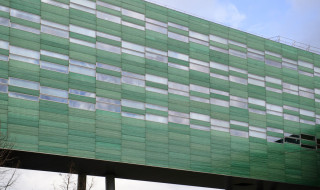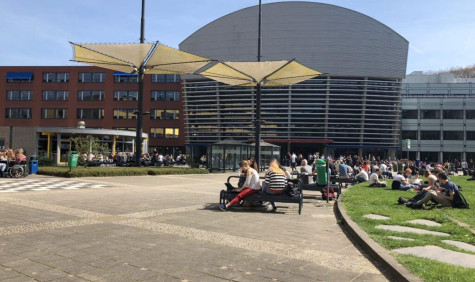Getting started with e-waste
HAN University of Applied Sciences and the University of Groningen have already achieved a great deal in preventing e-waste (electronic waste). With their tips and experiences they want to inspire you.
Since the end of 2016, Arnhem Nijmegen University of Applied Sciences (HAN) has been involved in our activities around e-waste sustainability. They have already taken several practical steps in the 2 years they have been working on the topic of e-waste. With their examples, we want to inspire you to start working with e-waste too.
New method to prevent e-waste
For HAN, the signing of the Raw Materials Agreement was an important reason to start making e-waste sustainable. This has led to new a new working method in terms of:
- reuse of products when someone leaves employment
- depreciation and/or replacement of products. These are disposed of sustainably and given a second life via the supplier
- use of IT products for other purposes. Some go to the educational environment after they have served in the business environment.
- raising awareness among employees of the facilities department and IT. To this end, they organise internal Circular Economy workshops.
- responsibility for the proper and tidy disposal of resources no longer in use. The IT organisation feels explicitly responsible for this. They make contractual agreements on this with the supplier.
Working on better embedding circular economy
In the next 2 to 4 years, strong efforts will be made to better embed circular economy within HAN in cooperation with education. Challenges include:
- adjusting policy on replacement. Here, too much steering is done on economic lifespan ("when something is written off it is replaced"). They are going to include the sustainability factor (is it really necessary to replace) in this loop.
- The rapid technical obsolescence of products (e.g. in the transition from Windows 7 to Windows 10) in relation to management costs. An important factor that comes into play when it comes to sustainability and IT.
SURF's role according to HAN: supporter and initiator
HAN uses our report Grip op e-waste and the flowchart presented in it:
- as a practical tool to determine their approach
- to work on raising awareness in the replacement process.
The HAN indicates that they see our role not only as helping in the process but emphatically as a catalyst to get other organisations moving.
University of Groningen (RUG)

In its Roadmap 2015-2020, the RUG sets goals for each pillar to make the university more sustainable. This includes pillars through which they have started working on the topic of e-waste. These are about:
- the reduction of total waste production in 2020 by at least 15% compared to 2005
- sustainable procurement: maximum green, socially and economically responsible
Results achieved in the field of e-waste
A spearhead of the RUG is a Sustainable Society. Sustainability is an important part of this. All parts of the RUG think about how they themselves can contribute to this. Within IT, e-waste quickly emerged as a use case. The RUG started working on this and has already realised the following nice steps:
- Decision to give computer equipment a longer depreciation period: Computers 5 years instead of 4 years and monitors 6 years instead of 4 years. This makes a considerable difference to the annual amount of e-waste.
- Every tender includes a paragraph on sustainable procurement. This contributes to a circular economy. E-waste is part of this.
- The establishment of a Green Office. The ICT departments within the RUG now work closely with it.
- Central collection of e-waste and European tendering for waste processing. Supplier Virol/Reisswolf provides the RUG with reports including the number of kilos and reusable raw materials. The RUG also looks at the required certifications of the market parties and the waste processor has all the necessary certificates.
- There is broad involvement in the collection, disposal and processing of e-waste:
- Facility managers & ict demand managers
- Green-Office
- Employees and students
- ict & AV employees
- Facility management
- Waste processor Virol/Reisswolf
Further improvements in the field of e-waste
The RUG wants to achieve even more in the field of e-waste:
- Further expand e-waste collection points.
- Use information screens to display reports on waste quantities and recovered raw materials.
- Additional focus on BYOD (bring your own device) with a campaign to collect old mobile phones.
- Give E-waste specific attention in European tenders (e.g. with guidance from the report Grip op e-waste).
- With the IT working group and the Green Office, take stock of the usability of mini computers as a workplace.
Feasibility of e-waste initiatives
A tip for other institutions is to just start. Small initiatives from the shop floor sometimes contribute more than large, imposed projects. The RUG, for example, has introduced that employees exchange their broken mouse at the service desk desk for a new one. This prevents the defective mouse from ending up in the bin and thus with the residual waste.
Costs are a big challenge. As long as things can be cost-neutral, it is easy to get the BoE on board. But if costs have to be incurred, things are more difficult. Another challenge is the market for second-hand equipment. This seems to have collapsed. It is therefore difficult to get rid of equipment. The risk increases that well-functioning equipment is disposed of rather than reused.
Reaching out to other institutions
The RUG wants to share its use cases and continue to participate and contribute to national meetings we organise. They consider e-waste a social problem and in this, educational institutions have a responsibility. Government institutions should collectively set an example in this. For more information about the RUG's experience, please contact Dries Gankema, demand manager at the RUG: a.j.gankema@rug.nl.
SURF's role according to the RUG: sharing knowledge and experiences
The RUG sees a role for us in:
- setting up a community for sustainability/e-waste where you can quickly get information on this topic and where use cases are collected.
- creating and maintaining an overview of all institutional contact persons working on this topic
- organising meetings around sustainability ewaste. According to the RUG, we have an overview of what is going on within the institutions better than any other educational institution.
The RUG has been involved in SURF meetings around ewaste sustainability since the beginning of 2017. In its own words, the meetings "each time provided inspiration to look further within the RUG at what more we can do than just placing e-waste containers".
The SURF report Grip op e-waste was presented within the RUG and handed out to those involved in the topic of e-waste.
Author: Timmy de Vos
